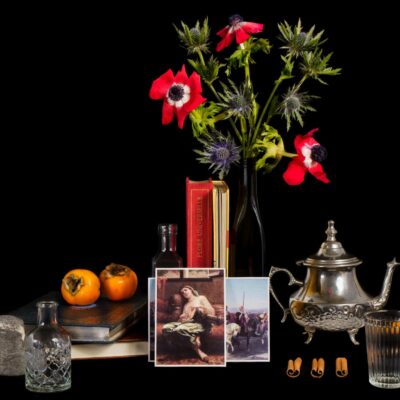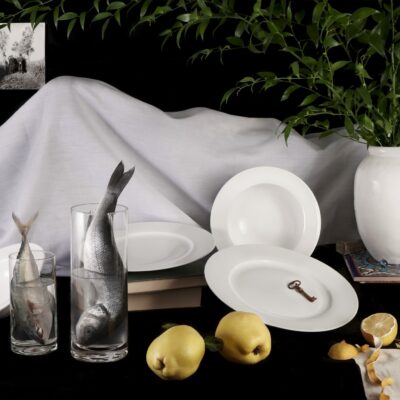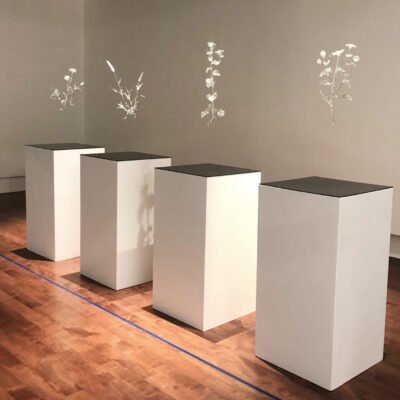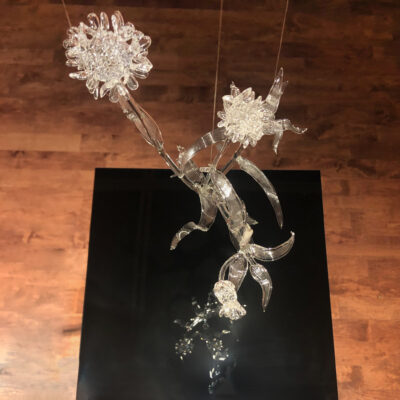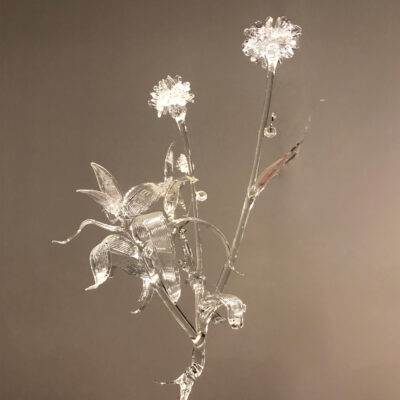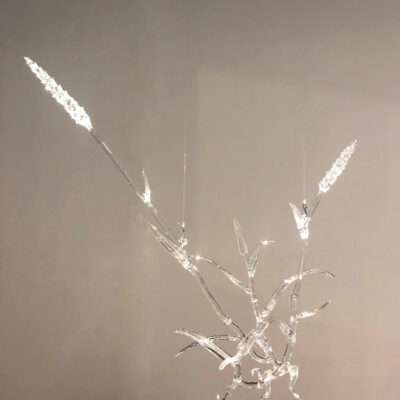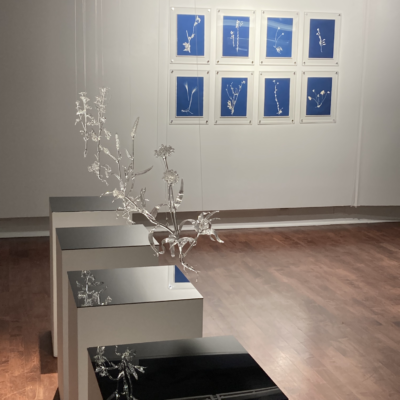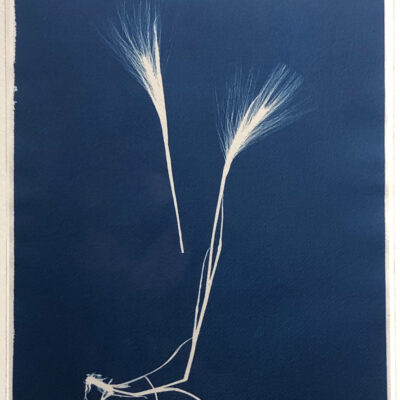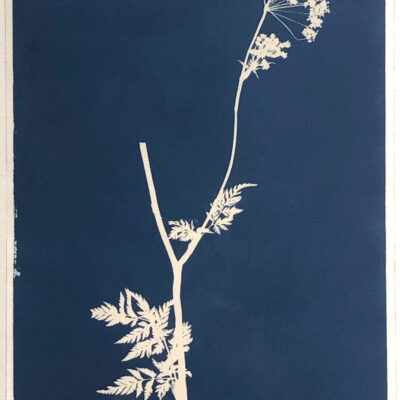Anahita Norouzi: Other Landscapes
Other Landscapes presents several multimedia works from Montreal-based Iranian artist Anahita Norouzi. It stems from her long-term research interest in the cross sections of botany and colonial politics, experiences of immigration and displacement, as well as issues of identity and memory.
Taking the form of a multimedia installation, the project results from a collaboration between the artist and eight refugees from the Middle East and Africa. Norouzi writes: ‘As a way to get closer to their stories, I focused on the objects that they brought with them on their journey. The small selection of belongings that they can bring along as they leave their lives behind adds a significant meaning to the status of these objects. Essentially, they embody what a person wanted to retain from their home.’
Through this body of work, Norouzi chooses to reappropriate methods of botanical photography and the 17th-19th century still life genre in order to engage in a decolonial reading of their history. Reversing roles and subverting the colonial gaze, here, immigrants from once-colonized countries are the ones collecting and transferring plants and objects from their native land to the West.
About the Artist
Anahita Norouzi is a multidisciplinary artist originally from Tehran. In 2010, she left her home country to pursue her studies in Montréal. She holds degrees in Fine Arts and French Literature from Concordia University. Norouzi excavates historical narratives in order to consider the global impact of colonialism and how it permeates contemporary culture. Her work is research-driven, instigated by marginalized or forgotten histories, and articulated across a range of materials and mediums, including sculpture, installation, photography, video, and performance. She is the winner of the 2021 Grantham Foundation Award and a finalist for the Magic of Persia Contemporary Art Prize, for pieces shown at the Royal College of Art in London and Dubai. www.anahitanorouzi.com
Exhibition Review
by Sabrina Schmidt
The Warren G. Flowers Art Gallery is currently hosting Anahita Norouzi’s multimedia installation, Other Landscapes. After meeting Anahita at the exhibition’s opening, she was later kind enough to speak with us over Zoom. There, she gave us insight into her process, inspirations, and experience collaborating with other artists and community members while putting together the exhibition.
Other Landscapes features a range of unconventional materials, from carefully executed cyanotypes of “invasive” species of plants, glass flowers suspended from the ceiling, and large scale photography inspired by the Dutch Golden Age tradition of still life, accompanied by audio recordings of refugees’ stories. This combination of disciplines is a product of Anahita’s curiosity and willingness to experiment, which translates into finding the most effective ways to communicate her ideas, even if this means opening up her practice to collaboration. In fact, Anahita’s process begins with research and a set of ideas before ever considering a medium. Having come to Montreal without speaking English or French, she relates her experience with multilingualism to the importance of meaningful self-expression that can go beyond language. Always looking to find “the best way to communicate an idea through different mediums” means Anahita took the time to speak with friends, family, and other artists about her ideas surrounding immigration, memory, and art. Still, this practice was only the beginning of an elaborate collaborative process.
Anahita collaborated with eight refugees from the Middle East and Africa whose memories and objects are celebrated in Other Landscapes. Of collaboration, Anahita remarks that the “most challenging part was to actually find people” who would be comfortable entrusting their personal narratives to “a stranger interested in their stories.” To find participants, she posted ads on Facebook and reached out to mutual friends and artists. Through this elaborate and time-consuming process, Anahita formed close bonds with many of the participants. As a result, her series of still life photographs combine knowledge which could only be gained through extensive communication with each participant.
For each refugee, Anahita created a conceptual portrait inspired by and critiquing the conventions of Dutch Golden Age Still Life paintings. In these photographs, the artist challenges this genre’s colonial narrative and the close bonds she had carefully cultivated with each participant, as she became responsible for their most treasured belongings. In this way, Anahita elevates the traditional vanitas framework by not only creating a beautiful picture, but by capturing the rich story behind each arrangement. The arrangements are made up of meaningful objects, photos, foods, and flowers given to Anahita by the participants. A single photograph displays these objects against a black background that strips the objects of context only to apply what Anahita describes as a “new concept which is suspension and displacement.” Consequently, the objects and refugees adopt the “lack of context as a new context.” Without a definite position in time and space, Anahita refocuses our attention on the psychological. In this way, the artist’s own experience between Iran and Montreal reflects the similar experiences shared with the refugees and creates a more in-depth profile of what it is to be geographically displaced.
Still working closely with her new friends, Anahita recalls a memory shared with her by one of the second-generation immigrant participants. In this memory, the refugee’s grandmother found a “sense of home” while taking a walk in the Quebec forest. There, she saw plants similar to those from her home country, many of which are labelled “invasive species” here in Canada. Anahita uses words like “invasive” and “foreign” as poignant reminders of the long-lasting legacy of European colonialism still evident in the language used to describe both legal and illegal immigrants. But while we are first struck by the negative connotation attached to these words, Anahita pointed out that there is strength to “invasive species.” She elaborates, suggesting that this language is “rhetoric” used to describe a more important quality of both invasive species of plant and immigrating people: resilience.
Anahita’s celebration of resilience is most noticeable in her series of cyanotype prints. These blue ink prints stand out as careful impressions of common dried weeds sent through the mail by relatives of the participants. Anahita is fascinated by both the science of these plants and by the idea that the scent of native plants can foster profound attachments to specific memories of home and of the participants’ families. As with the still life portraits, the cyanotype prints are a quick and efficient way of documenting the refugees’ experiences. Even further, this medium challenges the European colonial practice of using photography to document the people and resources in colonies. Then, the flowers become a symbol of displacement, because they can be traced from one place to another, just as a group of people can. To further emphasize the value of these botanical subjects, Anahita created a series of suspended glass sculptures which hang delicately from the gallery ceiling. Beneath each piece stands a plinth topped with a black plexiglass surface that reflects the underside of the carefully lit installation. In their reflections, we see the recurring motif of the black background in Anahita’s still lifes, and in the shadows, we see the simple impressions of the cyanotypes.
Combined, these three bodies of work form an exhibition that exudes what Anahita describes as a “rewarding,” “reassuring,” and “soothing” feeling of knowing that her experience is one shared by many. As students in the arts, the experience of speaking with an established artist like Anahita Norouzi about her exhibition, Other Landscapes, has been educational and gives us much to look forward to in the development of our own practices. We encourage you to go visit the exhibition and immerse yourself in all that it has to offer.
Sabrina Schmidt would like to thank Victoria Petrecca Berthelet for contributing to the editing of this essay.


